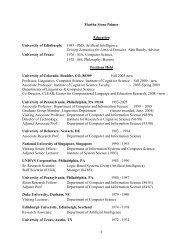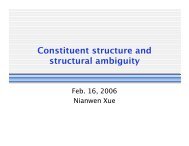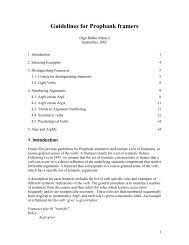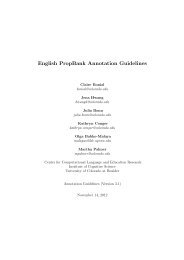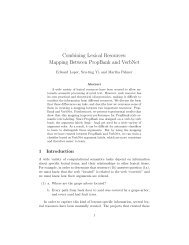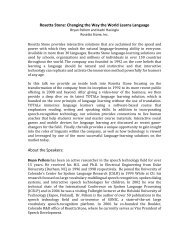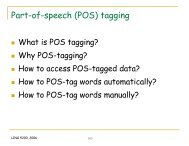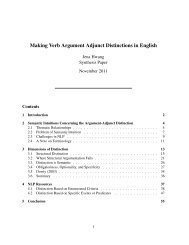Hindi PropBank Annotation Guidelines December ... - Verbs Index
Hindi PropBank Annotation Guidelines December ... - Verbs Index
Hindi PropBank Annotation Guidelines December ... - Verbs Index
You also want an ePaper? Increase the reach of your titles
YUMPU automatically turns print PDFs into web optimized ePapers that Google loves.
sentence until we reach the externalmost causer (which is ArgA). Thus we see that<br />
ARGA_MNS is one of the core arguments that can be repeated (i.e. multiple arguments<br />
can get it within the same sentence). In case of multiple ARGA_MNS arguments, the<br />
innermost causer (the rightmost) is the direct causer, the others are indirect causers.<br />
The logic behind employing the function tag MNS (means) is that the externalmost<br />
causer is using these intermediate causers as a means to get some action performed.<br />
These arguments are typically marked with either the postposition –se or a<br />
postpositional phrase –(ke) xvArA.<br />
72. [Sita ne ARGA] [mohan se ArgA_MNS ] [ram ko Arg0 ] rul-vAyA<br />
Sita erg mohan instr ram acc make-cry-CAUS<br />
‘Sita had/made Mohan make Ram cry’<br />
For the remaining arguments, we use numbered argument labels. Besides the<br />
normal labels Arg0, Arg1 and Arg2 used elsewhere too, we also use more specified<br />
labels, namely Arg0_MNS and Arg0_GOL for core numbered arguments in causative<br />
constructions. These are described below.<br />
The agent (doer) of an action, such as the agent of a verb “ronA” 'to cry' is<br />
marked Arg0 as is expected. The label Arg0_MNS (73a-b) is also used to annotate the<br />
doer of an action but when the doer is caused by a causer to perform the action and it<br />
is not the obvious recipient or beneficiary of the action. Please also note that this label<br />
is applied only when the the action is performed on an Arg1 argument, thus basically<br />
this label is used only when the event for the action is represented by a base<br />
unaccusative verb or a base transitive verb. The Arg0_MNS can also get postposition<br />
"se" or "xvArA" in some cases just like an ArgA_MNS can get these postpositions.<br />
Hence, note the postpositions "se" or "xvArA" are not limited to the argument marked<br />
as ArgA_MNS. In fact, there is a shared property between these two arguments<br />
(Arg0_MNS and ArgA_MNS) that these postpositions express, these postpositions are<br />
used with an argument that acts as a means to get some action done. Note Arg0_MNS<br />
is used as a means by its causer to achieve some result just as ArgA_MNS is used as<br />
a means by its causer to get some results, viz to get these arguments to perform some<br />
action. (this is observed with verbs such as giravA ‘cause (someone) to make<br />
(something) fall’, KulavA ‘cause (someone) to make (something) open’, tuRavA ‘cause<br />
(someone) to break (something)’, bikavA ‘cause to sell’ and so on.) When the base verb<br />
is an unergative verb, in that case, even when the causers are present, the doer of the<br />
action gets Arg0 label, not Arg0_MNS label. This is so because for an argument to be<br />
an Arg0_MNS, the caused argument has to perform an action on an Arg1 argument,<br />
but for base unergative verbs, that condition is not true.<br />
44



